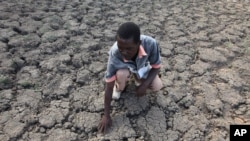Southern Africa's lengthy drought has gotten worse, aid officials say, and 13.8 million people are now staring down hunger as the lean season starts in the region.
These months before the next harvest are critical, says humanitarian coordinator Timo Pakkala. Food supplies are critically low because of poor harvests caused by the El Niño weather phenomenon, which has wrought havoc in the region since 2015.
“Now we are at the peak of the lean season, meaning that we still have some way to go to the next harvest, which is in March/April in most parts of Southern Africa," said Pakkala, the El Niño Coordinator for the U.N.’s Southern Africa Office for the Coordination of Humanitarian Affairs. "So this is where people are really the most stressed in coping with the lack of food and the poor water situation in many parts of Southern Africa.”
These food shortages are compounded by poor commodity prices and sluggish economies in the Southern African region, which can hamper governments’ ability to help by importing food.
And a drought doesn’t only hit bellies - the U.N. notes that in Malawi, some 137,000 children have been forced out of school, many daunted by the prospect of a hungry, thirsty trek to school - only to be followed by a hungry, thirsty day in the classroom.
Malawi is home to half the population dealing with food shortages, 6.7 million according to OCHA. Another three million live in Zimbabwe, with smaller numbers residing in Mozambique, Angola, Madagascar, Lesotho and Swaziland.
Unlike the mass devastation of a hurricane or earthquake, a drought slowly nibbles away at people’s meager food supplies and survival skills. That slow creep, Pakkala says, makes it harder to rouse donor funds.
“It’s a bigger challenge to mobilize resources and get the international development partners organized to support countries like is the case in Southern Africa,” he said.
The United Nations says they are facing a funding gap of about $550 million dollars. That money, they say, is the difference between giving millions of people full rations and allowing hundreds of thousands of children to wither from malnutrition.
Pakkala says the next harvest is likely to alleviate the situation, but that for many, it may be too late. The United Nations Children’s Emergency Fund has treated more than 82,000 children for severe acute malnutrition, but officials estimate that they need to reach 580,000 more in coming months.
For those children, the consequences of a long hungry spell won’t be so easily resolved. Poor nutrition leads to stunting and delays in brain development, which are irreversible.












